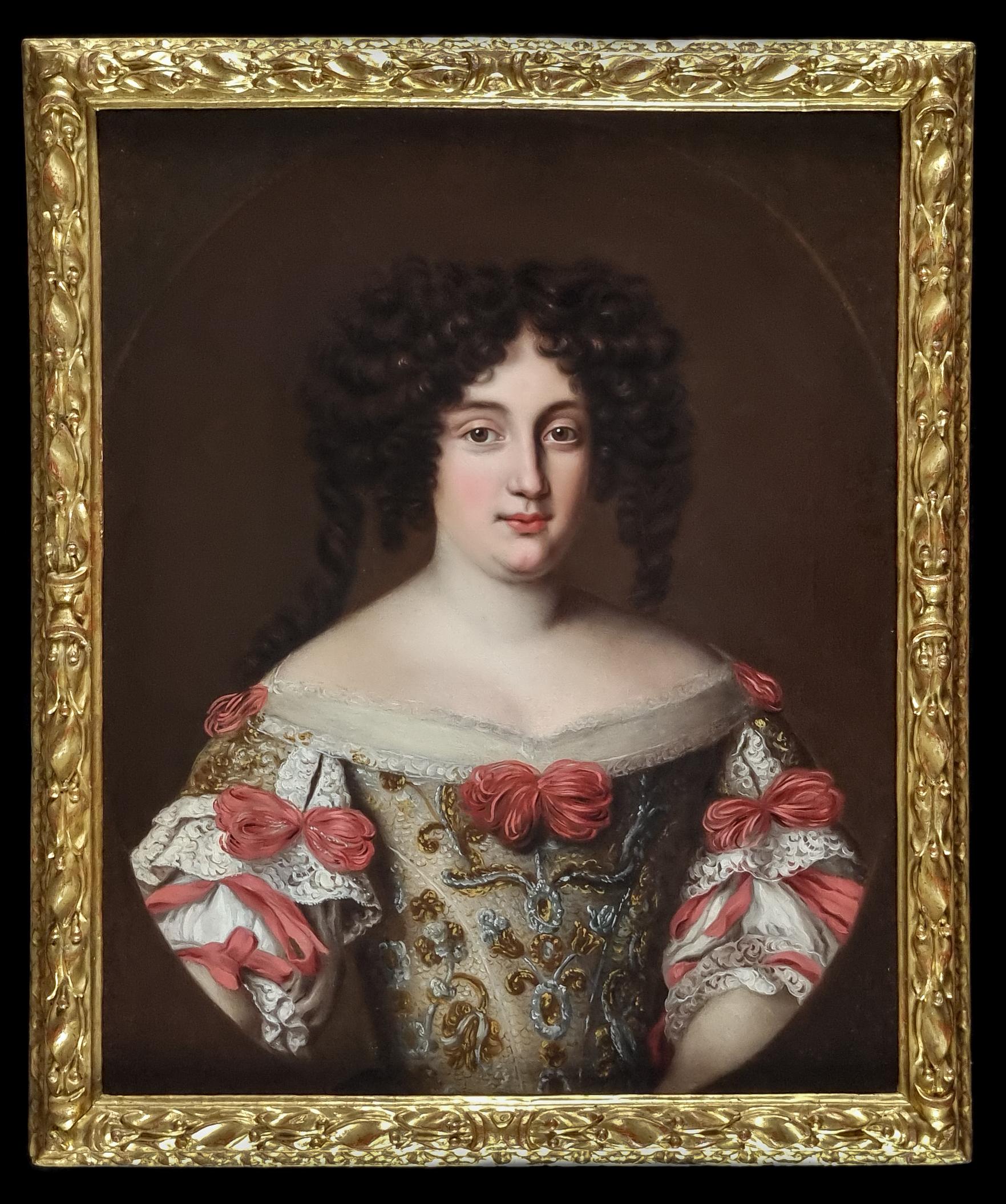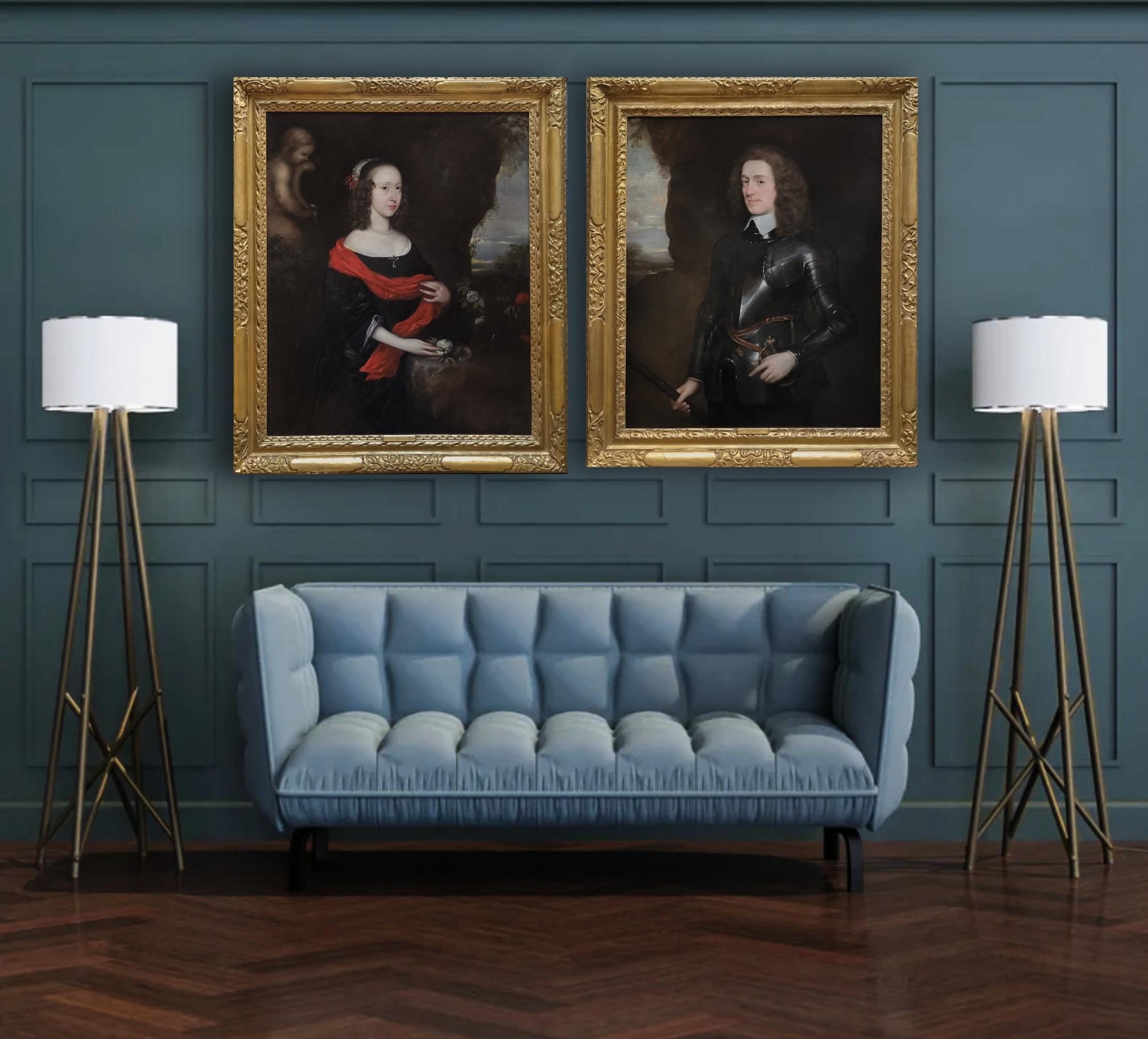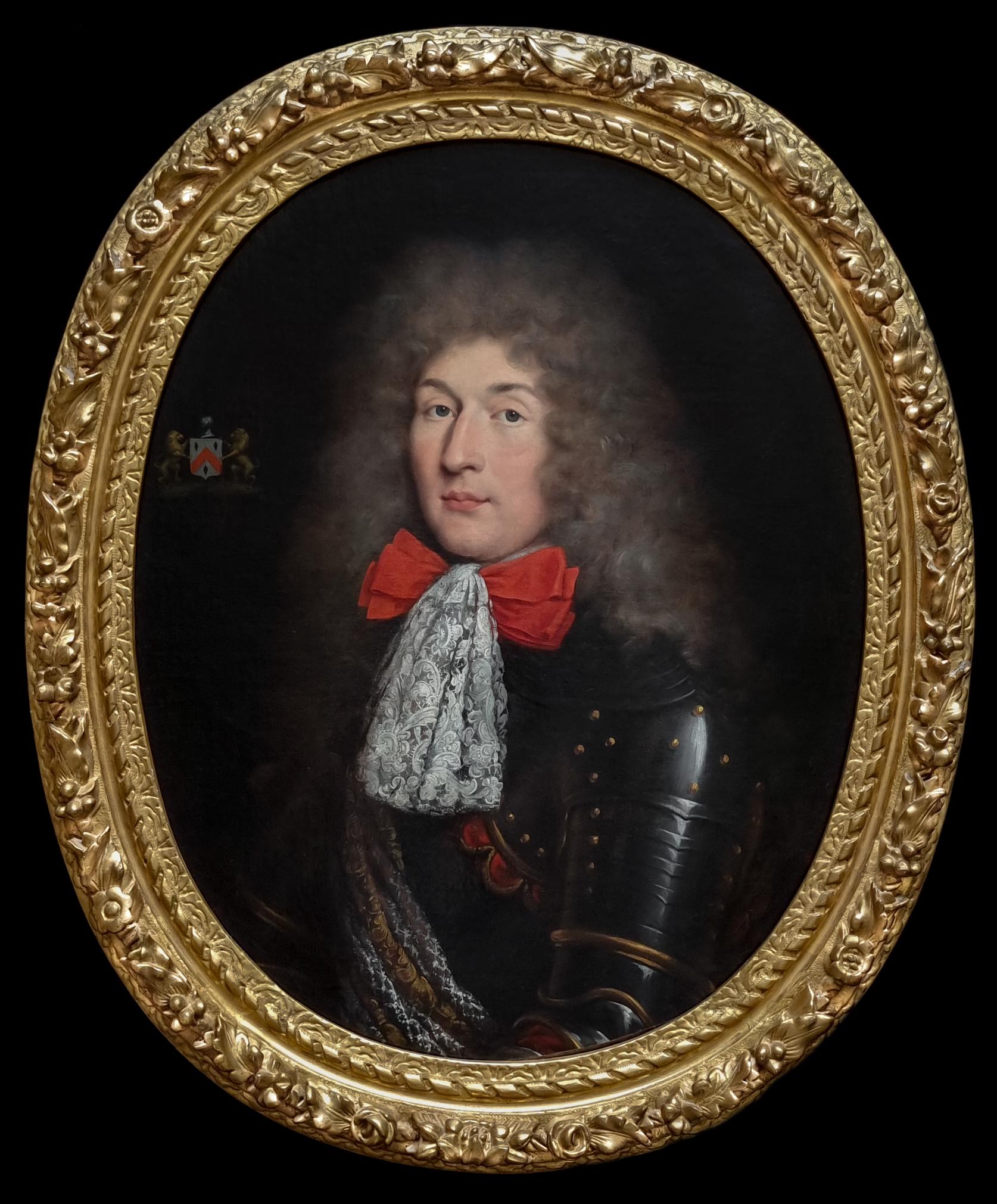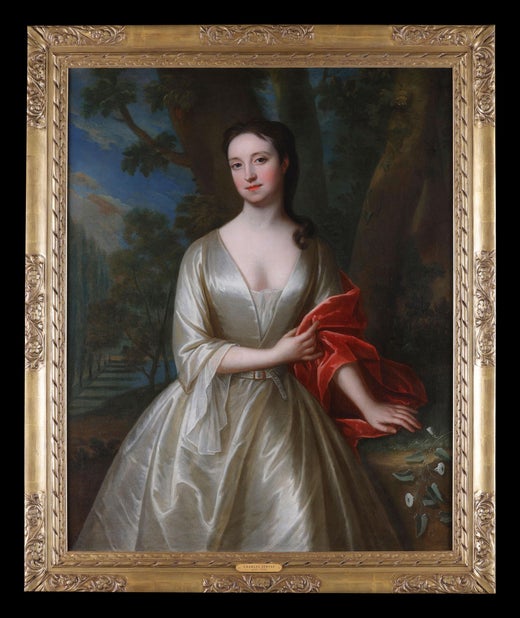Items Similar to Charles Jervas, Portrait of Joseph Mellish
Want more images or videos?
Request additional images or videos from the seller
1 of 5
Charles JervasCharles Jervas, Portrait of Joseph Mellish1710
1710
About the Item
Charles Jervas (1675-1739)
Portrait of Joseph Mellish (1675-1733)
Oil on canvas; held in a carved period frame
Dimensions refer to size of frame.
Provenance: Blyth Hall, Nottinghamshire, England; by descent to Sir Andrew Buchanan of Hodsock Priory, Nottinghamshire
In 1635 John Mellish, a merchant tailor of London, bought the estate of Blyth in Nottinghamshire. His son, a wealthy Oporto merchant, dying unmarried, left Blyth in 1703 to a cousin, Joseph Mellish, who became one of Newcastle’s earliest and most important political supporters in the county. He went up to Clare College, Cambridge in 1692 and on to the Inner Temple the following year. He married Dorothea Gore, daughter of Sir William Gore, Lord Mayor of London around 1707, a union which would have helped considerably in consolidating both the family business interests in London along with their political ambitions in the North of England. Joseph Mellish died in 1733, leaving three sons of whom the eldest, Edward, inherited Blyth, and the youngest, Joseph, was M.P. for Grimsby from 1761 to 1774.
Charles Jervas was an Irish portrait painter and translator. By the mid-1690s he was in London, where he stayed and trained with Sir Godfrey Kneller. Between 1698 and 1708 Jervas studied in Paris and Rome and acted as an agent for British art collectors. On his return to London he set up a successful portrait studio. With the help of his patron, Prime Minister Robert Walpole, Jervas secured the post of King’s painter. In this capacity he painted King George II, Queen Caroline and Prince William, Duke of Cumberland.
This portrait of Mellish was painted by Jervas around 1710. The large florid wig and the elegant, sumptuous gown compare favourably to other works by the artist from this period and is a striking example of his method of painting.
- Creator:Charles Jervas (1670 - 1739, Irish)
- Creation Year:1710
- Dimensions:Height: 36 in (91.44 cm)Width: 30.75 in (78.11 cm)Depth: 2 in (5.08 cm)
- Medium:
- Movement & Style:
- Period:
- Condition:
- Gallery Location:London, GB
- Reference Number:
Charles Jervas
Charles Jervas was born in Dublin in 1675 who later lived in England. After moving to England, Jervas became an apprentice to the painter Sir Godfrey Kneller. He later studied drawing in Rome and then returned (c. 1709) to England. Succeeding Kneller, he became court painter to the English kings George I and George II. His home became a centre for literary figures, among them Alexander Pope and Jonathan Swift, whose portraits Jervas painted, in addition to that of George II (1728). He produced a translation of Miguel de Cervantes’s Don Quixote (published posthumously, with his surname spelled Jarvis, in 1742).
About the Seller
No Reviews Yet
Vetted Seller
These experienced sellers undergo a comprehensive evaluation by our team of in-house experts.
1stDibs seller since 2019
9 sales on 1stDibs
- ShippingRetrieving quote...Ships From: London, United Kingdom
- Return PolicyA return for this item may be initiated within 14 days of delivery.
More From This SellerView All
- Henry Pickering, Portrait of a GentlemanBy Henry PickeringLocated in London, GBHenry Pickering, Portrait of a Gentleman Oil on canvas; signed and dated 1759; held in a giltwood period frame Provenance: Lenygon & Morant Ltd. c.1900; Knoedler, October 1912 (Sto...Category
Mid-18th Century Old Masters Portrait Paintings
MaterialsOil
- 18th century oil portrait of Margaret Peg Woffington by Jeremiah DavisonLocated in London, GBMargaret 'Peg' Woffington, was born in Dublin around 1714. Her charm and beauty as a child attracted much attention quickly resulting in her first stage role at the precocious age of 10. Her first important appearance was as Ophelia in 1737 in Dublin, followed by her greatest role, the male part of Sir Harry Windair in Farquhar's Constant Couple, which in 1740 led to her engagement by John Rich...Category
Mid-18th Century Old Masters Portrait Paintings
MaterialsOil, Canvas
- Follower of Samuel de Wilde, Portrait of an Actor in CharacterLocated in London, GBFollower of Samuel de Wilde c.1841 Portrait of an Actor in character. Oil on canvas; held in a period gilded frame. Dimensions refer to size of ...Category
19th Century Baroque Portrait Paintings
MaterialsCanvas, Oil
- Mather Brown (1761-1831) Portrait of Major-General John Robinson (1757-1819)By Mather BrownLocated in London, GBMather Brown (1761-1831) Portrait of Major-General John Robinson (1757-1819) Oil on canvas; held in a period giltwood frame Provenance: Denston Hall, Suffolk and by descent Literature: Suffolk Portraits, mss by Edmund Farrer, 1921. Vol. 5 (West Supp), entry 230, no.4 – NPG Heinz archive. John Robinson was a third generation professional soldier, whose father was a Lt.-Colonel. He joined the army in 1773 and was Captain by the time he married Rebecca Clive, daughter of “Clive of India” in March 1782. This family connection helped him immeasurably in his political ambitions as a seat in Parliament became available whilst his brother-in-law Edward, Lord Clive was in India. The portrait presented here was completed around 1805 when Robinson was a Major-General. This is confirmed by evidence that surrounds an incomplete portrait by George Romney of his late wife Rebecca. Unfinished at the time of Romney’s death, the painting remained unpaid for and unclaimed. On 25th March 1805, William Saunders, a framer, who had been looking after the work wrote to the artist’s son John Romney...Category
Early 19th Century Romantic Portrait Paintings
MaterialsOil
- Early 18th Century Oil After Francis Wheatley, The Taming of The ShrewLocated in London, GBAfter Francis Wheatley, circa 1800 The Taming of the Shrew Oil on canvas; held in a period style frame. Dimensions refer to size of frame ...Category
Early 1800s Old Masters Figurative Paintings
MaterialsOil
- 19th Century Framed Floral Painted PanelLocated in London, GBA late nineteenth century polychrome painted panel, depicting a foliate and ornithological arabesque upon a white ground. Oil on panel, set within an ebonised frame.Category
Late 19th Century Baroque Animal Paintings
MaterialsOil, Board
You May Also Like
- Portrait of a Lady, Maria Virginia Borghese Chigi Princess Farnese Oil on canvasLocated in London, GBThis exquisite portrait, presented by Titan Fine Art, belongs to a type of portrait known as ‘Les Belle Romanes’. Voet is perhaps best remembered for his series of them – a great set of portraits...Category
17th Century Old Masters Portrait Paintings
MaterialsCanvas, Oil
- Portrait Lady in Russet Silk Dress c.1710, Michael Dahl, oil on canvas paintingBy (Circle of) Michael DahlLocated in London, GBThis charming work is a good example of the type of portrait in vogue during the first quarter of the eighteenth century in Britain. The sitter, portrayed bust-length, wears a russet silk dress over a white chemise...Category
18th Century Old Masters Portrait Paintings
MaterialsCanvas, Oil
- Portrait of a Lady, Katherine St Aubyn, Godolphin, Cornelius Johnson, Oil canvasBy Cornelius JohnsonLocated in London, GBTitan Fine Art are pleased to present this charming bust-length portrait, which is a good example of the style of portrait painted in England in the second quarter of the seventeenth century. The attire consists of the finest silks, and the full billowing sleeves, bows, and hairstyle help in dating this portrait to circa 1637. The accessory par excellence – pearls – are worn as a necklace and were a very popular accessory. The artist makes no attempt to obey the rules of Baroque and instead sensitively depicts in complete honesty his sitter against a plain wall, and without distracting backdrops and flowing draperies – this work is very redolent of the sumptuous half-length female portraits that Cornelius Johnson...Category
17th Century Old Masters Portrait Paintings
MaterialsCanvas, Cotton Canvas, Oil
- Pair (2) Portraits Gentleman & Lady, William & Rachel Helyar c.1656, Civil WarBy Robert WalkerLocated in London, GBPortrait of Colonel William Helyar (1621-1698) and Rachel Helyar (c.1633-1678) c.1656 Circle of Robert Walker (act. 1637-1656) These fascinating portraits, presented by Titan Fine Art, depict Colonel William Helyar, High Sheriff of Somersetshire, and his wife Rachel Helyar nee Wyndham, a daughter and co-heiress of Sir Hugh Wyndham, 1st Baronet (died 1663) of Pilsden Court, Dorset. They are exquisite examples of portraiture during the Interregnum when England was under various forms of republican government. The history of the seventeenth century is in part the story of the Stewarts and their approach to government and the church; their ebbing and flowing popularity and the disastrous decisions that led to Civil War. But another fascinating dynasty also ruled Britain: the Cromwell’s. Between 1653 and 1659, following the Civil Wars and experimental Commonwealth, Oliver Cromwell governed as Lord Protector followed by his son Richard. Cromwell’s Protectorate is usually imagined as a grey, joyless, military regime. But the reality was rather different. Cromwell presided over a colourful and fashionable court where music and the arts flourished, masques were revived and the first English operas performed. Too often the London of the 1650s is painted as puritanical and repressive in contrast to the vivid, fun-loving capital of the Restoration. Yet, under Cromwell, this was the city where the first coffee houses were opening, where a young Samuel Pepys was embarking on his career as a civil servant with the patronage of one of Cromwell’s councillors and where Christopher Wren was enjoying his new Chair of astronomy at Gresham College, appointed after the personal intervention of Cromwell. When Cromwell was invested as Lord Protector for the second time in 1657, the lavish ceremony in Westminster Hall and procession through London matched any previous coronation for pageantry with thousands lining the streets, bells ringing, bonfires blazing and free French wine flowing through the city. The gentleman in our portrait is Colonel William Helyar (1621-1698), Sheriff of Somerset and as a Royalist during the English Civil War. As one of the most prominent old families of the South-West, the Helyar’s family roots in Somerset can be traced back to 1616 when the Reverend William Helyar (1559-1645), chaplain to Elizabeth I, who was also a cousin by marriage, purchased the family residence Coker Court in East Coker, Somerset. He married a Devonshire heiress and several estates were bestowed on him as a result. He was a warm supporter of Charles I in the Civil War and was in residence at Exeter in 1643 when the Parliamentarians pillaged the cathedral. Elderly as he was, he boldly resisted them, but was beaten, pelted with mud, and locked up in a ship in the port and only let out on payment of £800. He retired to Coker where he died in 1645. His eldest son Henry died in 1634 and he was succeeded by his grandson, Colonel William Helyar, the sitter in our portrait. Colonel Helyar raised a troop of horse for King Charles I and was a colonel in the king's army. He was at Exeter when it was captured by the Parliamentary forces in 1646 and thus deemed ‘Traitor to the Parliament’. His estates were sequestered, but they were returned and he was discharged and pardoned on payment of £1,522. During the Restoration he was a Sheriff and he also helped James II repel the Monmouth Rebellion. The companion portrait represents the Colonel’s wife, Rachel Helyar (baptised 24th June 1633 at St Mary Aldermanbury, London – died 1678). She was the youngest daughter and co-heir of Sir Hugh Wyndham, 1st Baronet of Pilsdon Court and Mary Wyndham nee Alanson (Sir Hugh should not be confused with his first cousin once removed from Somerset, also Sir Hugh Wyndham (bef. 1604 - 1684). Rachel is a thirteenth generation descendant of King Henry III. The couple resided at the family seat of Coker Court (interestingly, within the churchyard, lie the remains of the poet T.S. Eliot who once wrote a poem about East Coker). A marriage settlement in extant shows that the couple were married in 1656; the portraits were most likely painted to mark this important event in the sitter’s lives. Rachel holds roses, the flower of love, and the putto pouring water is representative of her purity, and possibly, the plighting of troth. Colonel Helyar wears a gold wedding band. The couple had four sons: George, William (MP) (1662-1742), John, and Richard. Colonel Helyar died in December 1697 and was buried at Whitechurch, Dorset 2 Jan 1698. This period in which this portrait was painted was known as the Protectorate (1653-1659). This period offered relative peace, as the English Civil War ended in 1651. It was an interesting time for portraiture in England and Scotland – in between the great artistic geniuses and dominance of Van Dyke and Peter Lely. Much of the foreign-born artistic talent had fled England and Scotland during the Civil War and the artists that had remained were in great demand, in part due to the newly exposed strata of society wishing to be painted. Sitters on both sides were depicted in portraits in very similar ways. They are not, on the whole, shown as the Roundheads and Cavaliers of popular history. In fact, it is usually impossible to guess their political allegiances from the style of their portrait and their Parliamentarian and royalist iconographies, as portraits on both sides followed the same conventions and looked identical. Colonel Helyar has been depicted in armour and holding a Marshal’s baton of command, confirming his status. There is a great sense of realism and a particular delicacy, note the finely rendered hand resting on the rapier. Rachel is wearing a satin dress with expansive sleeves and a crimson drapery over her shoulder and held up by her left hand. She wears large pearl...Category
17th Century Old Masters Portrait Paintings
MaterialsCanvas, Oil
- Portrait of a Lady in an Elaborate Stone Cartouche, Oil on canvas PaintingBy Mary BealeLocated in London, GBPortrait of a Lady in an Elaborate Stone Cartouche c.1675-80 Mary Beale (1632-1699) Titan Fine Art present this superb portrait where the sitter has been portrayed wearing a low-cut white chemise under a gold silk robe with a draped light...Category
17th Century Old Masters Portrait Paintings
MaterialsCanvas, Oil
- Portrait of Gentleman in Lace Cravat & Armour 1680’s Painting, Fine Carved FrameBy (circle of) Pierre MignardLocated in London, GBTitan Fine Art presents this portrait of a brave and chivalrous character. The gentleman has been depicted in armour, an elaborate full wig, and in accordance with the latest French fashion, an elaborate type of Venetian Gros point lace cravat and large silk bow (also called a cravat-string) – a type that were popular across Europe in the 1680’s. Point lace was fabulously expensive - a cravat was equivalent to six weeks income for a gentleman - and therefore indicative of a wearer's wealth and social class. A nobleman riding onto the battlefield would wear a lace cravat over his armour to demonstrate his status. The attire, along with the coat-of-arms, help to proclaim to every onlooker that the gentleman is a superior being. The depiction of the lace, apart from denoting the wealth of the sitter, was a deliberate way for the artist to demonstrate his own artistic ambition and technical skills Argent seasoned gule with three lozenges sable are those of the Crois family, who were minor nobility, originating from the Boulogne region in the north of France. The fact that the sitter is a high ranking noble excludes him as a member of the Crois family. As is so commonly the case, the coat of arms was a later addition, probably in the nineteenth century, by a family who sought to glorify their pedigree by adding their arms to the portrait. These arms are now an interesting part of the portraits history. The artist has captured a sense of the sitter’s character and the features of the sitter’s face have been rendered with great sensitivity. His confident gaze perhaps reflecting the near invincibility afforded by this steel suit. The work is a very good example of French portraiture from the period. Presented in an exquisite hand-carved and gilded seventeenth century frame - which is an exceptional work of art in itself. Pierre Mignard, known as le Romain, was a French painter of the court of the French King Louis XIV and was, with Charles Le Brun (1619-90), one of the most successful painters during the reign of Louis XIV. After training in Troyes, where he was born, and in Bourges, Mignard joined the studio of Simon Vouet in Paris in 1627. He went to Italy in 1636 and remained there until 1657. He studied the work of Correggio and Pietro da Cortona in Rome as well as copying Annibale Carracci's frescoes in the Palazzo Farnese. On Le Brun's death in 1690 he succeeded him as its Director and as First Painter to the King painting...Category
17th Century Old Masters Portrait Paintings
MaterialsOil, Canvas






